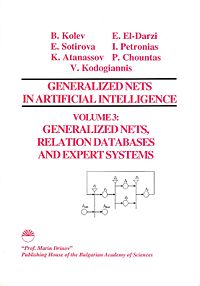Please check our Instructions to Authors and send your manuscripts to nifs.journal@gmail.com.
Generalized Nets in Artificial Intelligence. Volume 3: Generalized Nets, Relation Databases and Expert Systems

Generalized Nets in Artificial Intelligence. Volume 3: Generalized Nets, Relation Databases and Expert Systems is a book by Boyan Kolev, Elia El-Darzi, Evdokia Sotirova, Ilias Petrounias, Krassimir Atanassov, Panagiotis Chountas and Vassilis Codogiannis. The book is published in 2006 by "Prof. Marin Drinov" Publishing house of the Bulgarian Academy of Sciences, under ISBN 978-954-322-150-9.
Table of contents
- Preface
- Chapter 1. Generalized nets in modeling relational database management systems
- 1.1 Overview of database server processes
- 1.1.1 Query processing
- 1.1.2 Relational algebra operations
- 1.1.2.1 Selection operation [math]\displaystyle{ \sigma_{condition}(R) }[/math]
- 1.1.2.2 Join operation [math]\displaystyle{ R \times_{condition} S }[/math]
- 1.1.2.3 Projection operation [math]\displaystyle{ \Pi_{attribute \ list} (R) }[/math]
- 1.1.3 Transaction processing and concurrency control
- 1.2 GN model of query execution
- 1.3 GN representation of query execution plan
- 1.4 GN models of some relational algebra operations
- 1.4.1 Sort-merge join
- 1.4.2 Linear search selection
- 1.5 Transaction processing and concurrency control
- 1.6 GN model of transaction processing and concurrency control
- 1.6.1 Brief description of the model
- 1.6.2 Tokens and memory elements description
- 1.6.3 Detailed description of the model
- 1.7 Conclusions, application and future work
- 1.1 Overview of database server processes
- Chapter 2. Intuitionistic fuzzy generalized net analysis of concurrency control with deadlock detection in database systems
- 2.1 Periodic deadlock detection
- 2.2 Continuous deadlock detection
- 2.3 General model
- 2.4 Conclusions
- Chapter 3. Intuitionistic fuzzy relational databases
- 3.1 Introduction
- 3.2 Intuitionistic fuzzy relational model
- 3.3 Physical representation of the intuitionistic fuzzy relational model
- 3.3.1 Database_template_ifs_template
- 3.3.2 Type _ifs.bool
- 3.3.3 Predicates
- 3.3.4 Modifiers
- 3.4 Intuitionistic fuzzy SQL
- 3.4.1 Create database
- 3.4.2 Create table
- 3.4.3 Create predicate
- 3.4.4 Create modifier
- 3.4.5 Select
- 3.4.5.1 Target list
- 3.4.5.2 FROM clause
- 3.4.5.3 WHERE clause
- 3.4.5.4 GROUP BY clause
- 3.4.5.5 HAVING clause
- 3.4.5.6 MODIFY BY clause
- 3.4.5.7 Set operations - UNION and INTERSECT
- 3.4.6 UPDATE
- 3.4.7 Crisp relations
- 3.5 Enabling IFSQL support
- 3.6 Translation of the Intuitionistic Fuzzy SQL
- 3.7 An example
- 3.8 Conclusions and application
- Chapter 4. Intuitionistic fuzzy mediator
- 4.1 Introduction
- 4.2 Uncertainty in relational databases
- 4.3 The intuitionistic fuzzy tabular (IFRDB) model – the mediator level
- 4.4 Probabilistic data & intuitionistic fuzzy representation – binder level
- 4.4.1 Performing selection operation using IFRDBMS
- 4.4.2 Performing join using IFRDBMS
- 4.5 Null values intuitionistic fuzzy representation-binder level
- 4.6 Fuzzy data and its intuitionistic fuzzy representation-binder level
- 4.7 Concluding remark on the binder level
- 4.8 Enhanced query model constraints utilization
- 4.9 GN representation of the intuitionistic fuzzy mediator
- 4.9.1 Description of the places
- 4.9.2 Description of the GN
- Chapter 5. Generalized net model of an еxpert system with temporal components
- 5.1 Introduction
- 5.2 On two previous GN-models
- 5.3 Main results: tenth GN-model of ESS
- 5.3.1. The intuitionistic fuzzy logics of the tenth GN model
- 5.3.2. The specification of the tenth GN model
- 5.4 Conclusion
- Appendix A. Generalized nets
- Appendix B. Intuitionistic fuzzy logic
- Bibliography